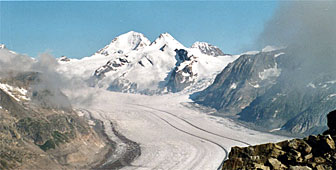Unesco may honour Jungfrau-Aletsch region

The "Jungfrau-Aletsch-Bietschhorn" region, marked by glaciers and towering mountains, is expected to be declared a Unesco World Heritage Site later this year. It would be the first time a natural region of the Alps is awarded the honour.
The high-alpine district, with its landscape of snow, ice and rock, offers surprising biodiversity. The Aletsch Glacier, jewel in the crown of Switzerland’s bid, contains nearly 30 billion tonnes of ice and, at 23 kilometres, is the longest glacier in the Alps.
The pine forest flanking the glacier, protected since 1933, represents another extreme. The centuries’ old Arve trees, gnarled by hurricanes, winter storms and summer drought, shelter alpine plants and endangered birds.
Combined, the glacier and the forest allow diverse ecosystems to survive side by side.
In all, the proposed heritage site covers more than 500 square kilometres, from the Aletsch Glacier and Forest to towering 4,000-metre peaks.
The Swiss-based World Conservation Union, which advises the World Heritage Committee, describes the Aletsch-Jungfrau-Bietschhorn region as “a dramatic mountain landscape bearing testimony to the formation processes of the High Alps and demonstrating classic examples of glacial activity.”
Melting landscape
The region’s inscription into the heritage list, the Conservation Union points out, would draw attention to the fragility of the rapidly receding alpine glaciers.
The Aletsch Glacier is receding at a rate of up to 30 metres a year, and has lost a significant portion of its mass in the last 150 years. Its slimmed down appearance is most noticeable at the tongue, where it has shed nearly 200 metres in thickness.
The majestic peaks of the Eiger, Mönch and Jungfrau mountains at the northern extension of the proposed heritage site fulfil another of the committee’s criteria in that they are considered of “exceptional beauty”.
The bid has the support of communities and organisations surrounding the site, but it has taken a quarter of a century for Switzerland’s bid to advance this far.
A bid was first mooted in 1975 shortly after the Swiss government ratified the “Convention concerning the protection of the World Cultural and Natural Heritage.” But the project was quickly shelved and wasn’t resurrected until 1995, a year dedicated to nature protection in Europe.
After five years of haggling at the community and federal levels, the Swiss finally presented to Unesco a smaller version of an alpine region already protected under Swiss law.
Interest groups concerned
Interest groups worried that the promise to Unesco to “protect the World Heritage Site for future generations” would kill plans to further develop tourism or hydroelectricity in certain spots. They managed to convince the local and federal governments to exclude these areas from the proposed site.
But it was only a partial success. The authorities have forced the indefinite shelving of plans to erect new cable car lines in the region, and ambitious plans to expand the Grimsel Dam have been scaled back.
The federal parliament is now considering a compromise proposal to allow a modest extension of the dam, which would not threaten sensitive moors in the area or encroach on the Unteraar Glacier, where pioneering scientific studies were done in the 19th century.
During an inspection tour of the Aletsch-Jungfrau-Bietschhorn region earlier this year, international experts indicated that they hoped the proposed World Heritage Site would be expanded in the near future to include at least the Unteraar Glacier.
While the Aletsch-Jungfrau-Bietschhorn region is likely to become the first natural region in the Alps inscribed as a World Heritage Site, it isn’t expected to be the last. A preliminary evaluation of Italy’s “Gran Paradiso” region has been carried out, while an effort to propose the Mont Blanc area has been temporarily halted.
Proponents of the Swiss bid say the Unesco designation would signify to the world the region’s irreplaceable heritage, and its value as a cultural and natural point of reference.

In compliance with the JTI standards
More: SWI swissinfo.ch certified by the Journalism Trust Initiative
You can find an overview of ongoing debates with our journalists here. Please join us!
If you want to start a conversation about a topic raised in this article or want to report factual errors, email us at english@swissinfo.ch.